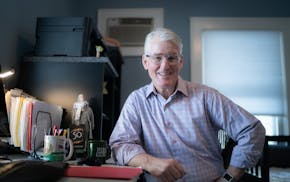Americans are still buying stuff like mad, with retail sales in October once again bounding way above the long-term trendline, even when adjusted for inflation.
The main stock market index got to another all-time high this week and house values in most markets have shot up, too.
Americans have also been quitting their jobs like never before. That might mean they've found a better job or it could be they're not worried enough about money to stick with a job they don't like.
And yet Americans haven't been this sour on the economy in a long time. There's a chance this will be the crabbiest Thanksgiving weekend since just after the Great Recession.
A wise columnist understands that asking worn down and cranky people to please lighten up and show some gratitude isn't likely going to help.
Plus, I'm not really one to talk. One reason these disappointing consumer confidence numbers seem believable is that I haven't been feeling so chipper myself.
The University of Michigan's consumer sentiment index has dropped to levels not seen in a decade. The score for current conditions — which measures how consumers feel about the economy right now — wasn't nearly as bad as the score that captured their pessimism about what lies ahead.
The investment strategist and economist Jim Paulsen, from the Leuthold Group in Minneapolis, is one of the financial pros who closely follow these measures. Millions of Americans have enough money to keep spending, which is why retail sales have kept cruising right along, he said last week. But they just don't feel that great.
He called Americans "scared" — and I think he's got it about right. As for what they might be afraid of, a good place to start is resurgent inflation.
At its latest measure, inflation is running north of 6% per year. Anyone who lived through the 1970s must be reminded of the struggles that came with that era's inflation and how painful it was when the Federal Reserve finally crushed it.
Inflation makes consumers miserable because they see businesses charging them more for an item than it was priced at yesterday. Wages were increasing in the 1970s, too, with the federal minimum wage rising from just $1.60 in 1974 to $3.35 by 1981. But there were stretches when wage increases lagged the price surges.
Consumers aren't just annoyed when their wage increases lag the rising cost of goods. They are also afraid that they'll keep slipping further behind.
So far this year wages have increased as employers struggle to fill their open jobs. Unionized workers have been emboldened as well.
At tractor and equipment maker Deere & Co., workers not only walked out on strike for the first time in 35 years, they rejected the first two negotiated contracts before finally approving the third. These workers got 10% raises this year, lump sum payments and other benefits.
But, as the economics writer Noah Smith pointed out in his essay about the genuine impacts of inflation on happiness, what if some of these hard-won pay increases turn out to be empty victories? What if price increases take every additional nickel?
Inflation is far from the only worry for Americans, of course. Product shortages and delays have popped up all over the economy. Having your new patio furniture finally arrive just after a long-planned wedding reception is annoying. Finding very few options when looking for an affordable used car, which you need to get to work or drop the kids off at school, feels much worse.
And looming over everything this year is the COVID-19 pandemic, still far from over. This week the COVID-19 crisis in Minnesota seems almost as dire as it was last year at this time, and local doctors and hospital managers are still pleading with people to get vaccinated and take the virus seriously.
"The whole thing has a death count associated with it," Paulsen said. "I don't remember any other crisis with a death count comparable to a war-time death count. It's happening right here, in our backyard. And the darn thing just won't go away."
It's the uncertainty about what's going to happen that wears us down, worse in many ways than thinking about a serious problem with a more knowable end.
"I understand why people, when you say, 'How you doing?' they'll say, 'Well, not that great,'" Paulsen added.
I am partly convinced that this year's inflation is actually not like what happened in the 1970s at all. It's more like the short-lived inflation spurt that took place in the late 1940s as Americans tried to get back to normal after a terrible war.
Even so, we won't know for sure for a while, and that does little to comfort us now.
But, as odd as it may sound, all this pessimism has Paulsen feeling pretty optimistic. It's a little like what happens at the bottom of recessions, with people stuck in a funk even as economic conditions have already started getting better.
This kind of negativity is a form of excess capacity, a sign of eventual growth, Paulsen said. Put another way, it's like the human equivalent of an idled manufacturing line just waiting to get turned back on, staffed up and producing lots of value again.
He reminded me of an old expression in investing — how markets "climb a wall of worry." That's when investors might be nervous about all sorts of risks and this feeling hangs over the stock market, even as businesses keep reporting solid earnings and the stock market indexes inch up.
It's a pretty good metaphor for thinking about our lives right now. We're still moving up, but lots of us — myself included — are crawling up a wall of worry.
So here's how I've decided to think about it: Either what's worrying so many of us right now really happens, and then we invariably find a way through it, or it doesn't happen at all, and that's far more likely. We will likely all start breathing a little easier once we realize that.
As we wind down our second worrisome fall season of the pandemic era, I'm hoping that's enough for us to be thankful.

Schafer: What do you really need to retire?

Schafer: How doing business can be a bit more like Christmas morning

Schafer: There won't soon be another opportunity to rethink the I-94 corridor

Schafer: The fruits of Honeywell's long-game dedication to quantum computer now being seen


